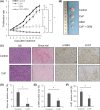Conophylline suppresses pancreatic cancer desmoplasia and cancer-promoting cytokines produced by cancer-associated fibroblasts
- PMID: 30353606
- PMCID: PMC6317962
- DOI: 10.1111/cas.13847
Conophylline suppresses pancreatic cancer desmoplasia and cancer-promoting cytokines produced by cancer-associated fibroblasts
Abstract
Despite recent advances in cancer treatment, pancreatic cancer is a highly malignant tumor type with a dismal prognosis and it is characterized by dense desmoplasia in the cancer tissue. Cancer-associated fibroblasts (CAF) are responsible for this fibrotic stroma and promote cancer progression. We previously reported that a novel natural compound conophylline (CnP) extracted from the leaves of a tropical plant reduced liver and pancreatic fibrosis by suppression of stellate cells. However, there have been no studies to investigate the effects of CnP on CAF, which is the aim of this work. Here, we showed that CAF stimulated indicators of pancreatic cancer malignancy, such as proliferation, invasiveness, and chemoresistance. We also showed that CnP suppressed CAF activity and proliferation, and inhibited the stimulating effects of CAF on pancreatic cancer cells. Moreover, CnP strongly decreased the various cytokines involved in cancer progression, such as interleukin (IL)-6, IL-8, C-C motif chemokine ligand 2 (CCL2), and C-X-C motif chemokine ligand 12 (CXCL12), secreted by CAF. In vivo, CAF promoted tumor proliferation and desmoplastic formation in a mouse xenograft model, CnP reduced desmoplasia of tumors composed of pancreatic cancer cells + CAF, and combination therapy of CnP with gemcitabine remarkably inhibited tumor proliferation. Our findings suggest that CnP is a promising therapeutic strategy of combination therapy with anticancer drugs to overcome refractory pancreatic cancers.
Keywords: conophylline; cytokine; fibroblast; microenvironment; stellate cell.
© 2018 The Authors. Cancer Science published by John Wiley & Sons Australia, Ltd on behalf of Japanese Cancer Association.
Figures






Similar articles
-
Desmoplasia suppression by metformin-mediated AMPK activation inhibits pancreatic cancer progression.Cancer Lett. 2017 Jan 28;385:225-233. doi: 10.1016/j.canlet.2016.10.019. Epub 2016 Oct 20. Cancer Lett. 2017. PMID: 27773749
-
Cancer-associated fibroblasts promote progression and gemcitabine resistance via the SDF-1/SATB-1 pathway in pancreatic cancer.Cell Death Dis. 2018 Oct 18;9(11):1065. doi: 10.1038/s41419-018-1104-x. Cell Death Dis. 2018. PMID: 30337520 Free PMC article.
-
Pirfenidone inhibits pancreatic cancer desmoplasia by regulating stellate cells.Cancer Res. 2013 Apr 1;73(7):2345-56. doi: 10.1158/0008-5472.CAN-12-3180. Epub 2013 Jan 24. Cancer Res. 2013. PMID: 23348422
-
Cancer-associated fibroblasts that restrain cancer progression: Hypotheses and perspectives.Cancer Sci. 2020 Apr;111(4):1047-1057. doi: 10.1111/cas.14346. Epub 2020 Mar 10. Cancer Sci. 2020. PMID: 32060987 Free PMC article. Review.
-
Recent advances in understanding cancer-associated fibroblasts in pancreatic cancer.Am J Physiol Cell Physiol. 2020 Aug 1;319(2):C233-C243. doi: 10.1152/ajpcell.00079.2020. Epub 2020 May 20. Am J Physiol Cell Physiol. 2020. PMID: 32432930 Free PMC article. Review.
Cited by
-
Targeting Tumor Microenvironment for Cancer Therapy.Int J Mol Sci. 2019 Feb 15;20(4):840. doi: 10.3390/ijms20040840. Int J Mol Sci. 2019. PMID: 30781344 Free PMC article. Review.
-
Paracrine signaling in cancer-associated fibroblasts: central regulators of the tumor immune microenvironment.J Transl Med. 2025 Jun 23;23(1):697. doi: 10.1186/s12967-025-06744-4. J Transl Med. 2025. PMID: 40551209 Free PMC article. Review.
-
Natural Compounds as Protease Inhibitors in Therapeutic Focus on Cancer Therapy.Anticancer Agents Med Chem. 2024;24(16):1167-1181. doi: 10.2174/0118715206303964240708095110. Anticancer Agents Med Chem. 2024. PMID: 38988167 Review.
-
Adaptive Mechanisms of Tumor Therapy Resistance Driven by Tumor Microenvironment.Front Cell Dev Biol. 2021 Mar 1;9:641469. doi: 10.3389/fcell.2021.641469. eCollection 2021. Front Cell Dev Biol. 2021. PMID: 33732706 Free PMC article. Review.
-
Role of Phytoconstituents in Cancer Treatment: A Review.Recent Adv Food Nutr Agric. 2024;15(2):115-137. doi: 10.2174/012772574X274566231220051254. Recent Adv Food Nutr Agric. 2024. PMID: 38369892 Review.
References
MeSH terms
Substances
Grants and funding
LinkOut - more resources
Full Text Sources
Medical
Research Materials

